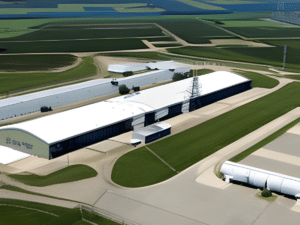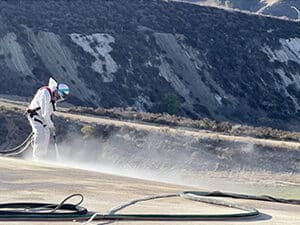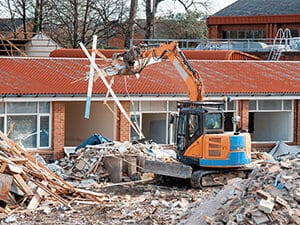The Logistics Behind Industrial Real Estate Construction

Industrial real estate refers to properties that are specifically designed and utilized for industrial purposes. These properties are used for activities such as manufacturing, warehousing, distribution, research and development, and other industrial activities. Industrial real estate construction is a crucial component of the commercial real estate market and plays a significant role in supporting various industries and supply chains.
The following are just a few types of Industrial Real Estate:
- Manufacturing Facilities: These properties are designed to house manufacturing operations. They may include factories, plants, and facilities where goods are produced on a large scale.
- Warehouses and Distribution Centers: These properties are used for storing and distributing goods before they reach the end consumers. They are essential in supply chain management and logistics.
- Flex Space: Flex industrial properties combine elements of both office and warehouse spaces. They offer the flexibility to accommodate a range of uses, including office space, light manufacturing, and storage.
- Research and Development (R&D) Facilities: These properties are used for research, product development, and testing. They are commonly found in technology and pharmaceutical industries.
Due to a variety of global economic and supply chain factors, the demand for Industrial Real Estate facilities has drastically increased across the U.S. Investing in industrial real estate can be attractive due to stable income potential, long-term leases, and the essential role they play in supporting various industries. Additionally, the growth of e-commerce and global trade has increased the demand for modern industrial properties with advanced logistics capabilities. However, Industrial Real Estate developers and other project stakeholders should consider the specific regulatory and environmental requirements that should be met before breaking ground.
Important Characteristics of Industrial Real Estate to Consider During Construction
Unlike standard commercial real estate projects, such as retail centers, Industrial Real Estate projects come with a unique set of characteristics that inform the design of ancillary environmental and hazardous material mitigation.
- Location: Industrial properties are typically located near transportation hubs, major highways, ports, and airports to facilitate efficient movement of goods.
- Size: Industrial properties tend to be larger in size compared to other types of commercial real estate to accommodate machinery, equipment, and storage needs.
- Clear Height: Industrial buildings often have high ceilings (clear height) to accommodate tall equipment and stack goods vertically.
- Loading Docks: Warehouses and distribution centers have loading docks to facilitate the loading and unloading of goods from trucks.
- Heavy-Duty Infrastructure: Industrial properties require specialized infrastructure to handle heavy machinery, power needs, and specific industrial processes.
- Zoning Regulations: Local zoning laws often dictate where industrial properties can be located, separating them from residential and commercial areas due to potential noise, traffic, and environmental impacts.
What Type of Survey Is Needed for an Industrial Real Estate Project?
For an industrial real estate construction project, several types of surveys may be required to ensure proper planning, compliance with regulations, and the successful completion of the project. The specific surveys needed will depend on the location, size, and nature of the project and project scope. It will also depend upon if the project will require the removal of existing structures to clear an area for the development of industrial buildings. In some cases, existing industrial properties are cleared for redevelopment into new logistics or industrial facilities.
Here are some common types of surveys typically required for industrial real estate construction projects:
- Hazardous Building Materials Assessment: A hazardous building materials assessment ascertains the presence of asbestos-containing materials in buildings that will be demolished and removed from the property to make way for a new industrial type building. Included in this type of assessment is determining if lead-based paint, asbestos-containing materials, polychlorinated biphenyls, are present as well as universal wastes prior to the demolition of existing building structures.
- Environmental Site Assessment (ESA): An ESA assesses potential environmental contamination on the property, especially if it has a history of industrial or hazardous materials use. This assessment is essential for identifying any environmental risks and complying with environmental regulations.
Other Surveys that may be necessary for a construction project include:
- Geotechnical Survey: A geotechnical survey evaluates the soil and subsurface conditions of the site. It helps engineers and designers understand the soil’s load-bearing capacity, stability, and potential challenges during construction.
- Noise and Air Quality Assessment: For certain industrial projects, especially those near residential areas, a noise and air quality assessment may be necessary to evaluate potential impacts on the surrounding environment.
- Floodplain Survey: If the site is located in a flood-prone area, a floodplain survey determines the extent and potential impact of flooding on the property.
- Archaeological Survey: In some cases, especially if the project site has historical significance, an archaeological survey may be required to identify and preserve any cultural artifacts or archaeological remains.
It’s essential to consult with local authorities, engineers, and surveying professionals to determine the specific surveys required for your industrial real estate construction project. These surveys not only aid in the planning and construction phases but also help ensure compliance with regulatory requirements and environmental standards.
Why Conduct a Noise and Air Quality Assessment?
A Noise and Air Quality Assessment is a comprehensive study conducted to evaluate the potential impact of a proposed industrial or development project on the surrounding environment’s noise levels and air quality. The assessment aims to identify potential sources of noise and air pollution from the project and determine whether they comply with local regulations and environmental standards. The study is typically required as part of the environmental impact assessment process before a construction project can be approved.
What Does a Hazardous Building Materials Assessment Accomplish?
A Hazardous Materials Building Assessment, also known as a Hazardous Materials Survey or Phase I Environmental Site Assessment (ESA), is an essential process in industrial real estate development. The assessment aims to identify and evaluate potential hazardous materials and environmental contamination present on or near the property where the industrial development is proposed. It provides crucial information for developers, investors, and regulatory authorities to make informed decisions about the project’s feasibility, safety, and compliance with environmental regulations.
The key objectives of a Hazardous Materials Building Assessment are as follows:
- Identification of Hazardous Materials: The assessment aims to identify any hazardous materials that may be present on the property or in nearby buildings. These materials could include asbestos, lead-based paint, polychlorinated biphenyls (PCBs), mold, and other potentially harmful substances commonly found in older commercial and industrial buildings.
- Evaluation of Environmental Contamination: The assessment investigates the potential for soil and groundwater contamination from historical or current industrial activities, leaking underground storage tanks, chemical spills, or other sources of pollution from manufacturing activities.
- Compliance with Hazardous Materials Regulations: The assessment helps determine whether the industrial real estate development complies with environmental regulations and requirements set by local, state, and federal authorities. It ensures that the proposed development will not pose significant risks to human health or the environment.
- Hazardous Materials Risk Assessment: The findings of the assessment allow developers to assess potential risks associated with the presence of hazardous materials and environmental contamination. It helps in making informed decisions about site remediation and potential liabilities.
- Due Diligence for Industrial Real Estate Development: Conducting a Hazardous Materials Building Assessment is part of the due diligence process for industrial real estate development. It helps potential buyers or investors understand the environmental conditions, risks and financial impacts of the property before making investment decisions.
- Remediation Planning: If hazardous materials or environmental contamination are found, the assessment provides a basis for planning remediation efforts to clean up the site and mitigate potential risks. Remediation may involve the safe removal and disposal of hazardous materials, contaminated soil, underground storage tanks or other environmental site issues.
- Project Cost Estimation: The assessment findings play a significant role in estimating the overall project costs. Remediation efforts and compliance with environmental regulations may add expenses that need to be considered during project planning.
- Liability Protection: Conducting a Hazardous Materials Building Assessment is often crucial for liability protection. If a development project causes harm to human health or the environment due to pre-existing contamination, the assessment can help demonstrate that appropriate due diligence was conducted.
By conducting a thorough Hazardous Materials Building Assessment and Phase 1 Environmental Site Assessment industrial real estate developers can identify potential environmental risks and take appropriate measures to ensure the safety and environmental compliance of their projects. Additionally, it helps protect their investments by addressing environmental concerns and ensuring a smoother permitting process with regulatory authorities.
Let Omega Streamline Your Industrial Real Estate Project with Expert Environmental Assessments
Omega Environmental Services staff are experts in conducting environmental site assessments, noise and air quality assessments, and hazardous material mitigation strategies. Complex construction projects Omega’s staff is available now to discuss environmental and regulatory needs for your next industrial real estate project.










